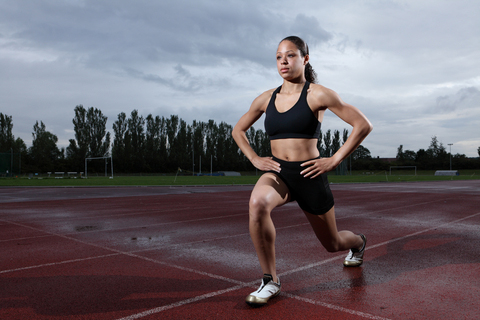Injury Prevention During Exercise
by Tim Allardyce
01 February 2012
While exercise is one of the key ingredients for health, it also comes with a risk of injury if proper precautions are not followed. Differences in anatomical and physiological factors make women more prone to certain types of injuries compared to men. For example, female athletes have been reported to be 2-8 times more likely to be affected from injury to the knee or the ankle compared to males. Nevertheless, follow all of the advice in this article and you will certainly reduce your risk of getting injured.
Warming Up
A proper warm up is one of the vital steps towards injury prevention. Our muscles and joints love being warm prior to exercise, and this makes them function more efficiently. Warm muscles stretch better, and so your risk of cramping and strains are reduced.
If you are not that clued up with dynamic warm up routines, don’t worry too much! One of the best ways to warm up is to actually do the sport or exercise, but at a lower intensity. This prepares the muscles for work, and circulates the blood to the limbs helping with muscle contraction. For example, if you want to go for a jog, start warming up with a brisk walk. Want to start skiing? Start with a gentle blue run first and take it slowly, until your muscles feel ready to tackle more difficult slopes.
Stretching is an easy way to limber up, but research is now telling us that you should stretch at least one hour prior to exercise. If you are not used to stretching, start slowly and gently because you can cause injury by stretching too hard.
Exercise Smart
Always remember to pace yourself. Exercise to your limits, and listen to your body. The moment you start to feel tired you are far more likely to get injured. You should also respect your age; if you are an older woman you may not have the same flexibility as you did when you were younger. Therefore, always choose an exercise that suits your needs, abilities and fitness levels. An osteopath or a personal trainer can be handy at such times to determine your current ability and strength levels, and give you a better indication of how hard to push yourself.
The Principal of Progression
The training principle of progression shows that by increasing exercise sessions slowly, the body gets greater benefit. Its easy to get over-motivated when you first start exercising by thinking you can go out and do a 10 mile run, or go and swim 20 lengths of your pool. This will simply increase your risk of injury. Build up the training gradually by gently increasing workload each week. Don’t be keen to progress too fast, instead build strong foundations.
Delayed Onset Muscle Soreness (DOMS)
DOMS is that soreness in your muscles which usually starts a few hours after exercising, and peaks within 48 hours. Soreness is directly related to overuse of the muscles and a build up of lactic acid. Any activity during which the muscles produce higher forces than usual, or for a longer duration can result in muscle soreness. One way to reduce the amount of DOMS is to have a cool down routine following exercise, and to gently stretch the muscles which avoids over contraction of the muscle fibres.
Correct Kit & Right Gear
Choosing the right kit for the type of exercise that you want to begin is very much essential to prevent injuries. You should choose the right clothing to protect you against cold (such as thermal underwear, or wearing an extra layer of clothes in wet conditions). Shoes should be the right fit and comfortable; and ideally suited to your particular sport. You wouldn’t do a 10km run in platforms would you? Get yourself along to your local running shop and get fitted for a good pair of running shoes instead. Use proper safety gear such as helmets, knee and elbow guards if its applicable to your type of sport. Safety gear is becoming much more fashionable – just look at how many female snowboarders and skiers now wear safety helmets and crash pants.
Eating & Drinking
Its generally advised to eat a light nutritious meal about 2 to 4 hours before exercise. Food such as fresh fruit, bread, energy bars and drinks can all be useful in moderation. Working out immediately after having food or on a full stomach can lead to tummy upset, nausea and vomiting. Hence it’s a complete no-no. However, working on empty stomach is also not advisable as you need the energy from the food.
Keeping your body well hydrated is equally important. The body loses water rapidly based on the heat and exertion levels. So it is important to be well hydrated before you begin your exercise and regularly rehydrate yourself during the exercise. Drinking about ½ to 1 cup of water every 20-30 minutes is advised during a work out.
Resting & Recovery
You should attempt to leave 48 hours between working out a particular muscle group. This is most important for strength training. Adequate rest and proper cooling down methods are necessary to ensure complete recovery of the muscles. Cooling down with low intensity exercise helps prevent pooling of blood in the legs and also clears the lactic acid formed during exercise. This concept has been referred to as ‘active recovery’ whereby an individual performs low-intensity exercise after workouts to encourage recovery. Studies have found that active recovery produced the most significant reduction in injury. An example of an active recovery exercise would be gently cycling for 10 minutes following a long run, or swimming following an aerobics work out.
Benefits of seeing an Osteopath
Visiting an osteopath before beginning an exercise program can offer benefits such as identifying any weak muscles or joints, and then prescribing exercises or treatment to help restore any imbalance. Many elite sports performers now visit osteopaths not only to prevent injury, but also to improve performance. By identifying a particular weakness in the body you can actually improve your strength, endurance and co-ordination.
This article was written by Tim Allardyce, you can see all his articles here.






